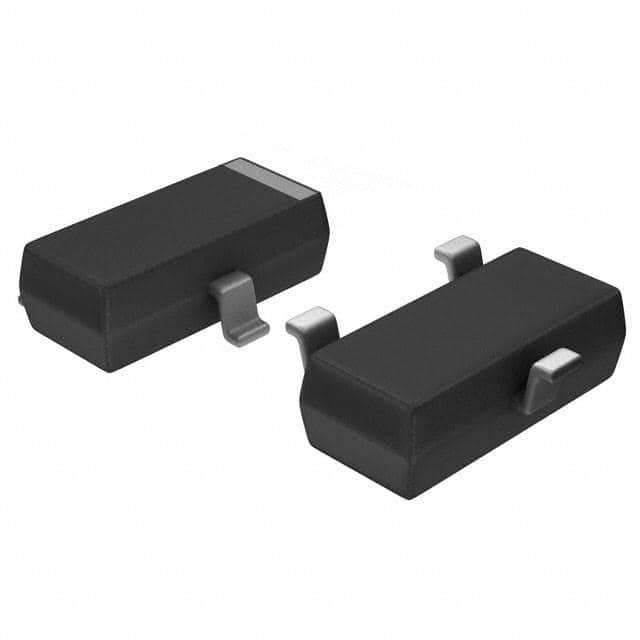Xem thông số kỹ thuật để biết chi tiết sản phẩm.

BAT54C Diode: Encyclopedia Entry
Introduction
The BAT54C diode is a versatile and widely used component in the field of electronics. This entry provides an in-depth overview of the BAT54C diode, including its product category, basic information, specifications, pin configuration, functional features, advantages and disadvantages, working principles, application field plans, and alternative models.
Product Category
The BAT54C diode belongs to the category of Schottky diodes, which are semiconductor devices known for their low forward voltage drop and fast switching capabilities.
Basic Information Overview
- Use: The BAT54C diode is commonly used in various electronic circuits for applications such as signal rectification, voltage clamping, and reverse polarity protection.
- Characteristics: It exhibits low forward voltage drop, high switching speed, and low leakage current, making it suitable for high-frequency applications.
- Package: The BAT54C diode is typically available in a SOT-23 package.
- Essence: Its essence lies in providing efficient rectification and voltage clamping in electronic circuits.
- Packaging/Quantity: It is commonly available in reels or tubes containing a specified quantity per package.
Specifications
The BAT54C diode has the following specifications: - Forward Voltage Drop: 0.32V (at 1mA) - Reverse Voltage: 30V - Maximum Continuous Forward Current: 200mA - Reverse Recovery Time: 4ns
Detailed Pin Configuration
The BAT54C diode has a three-pin configuration, with the following pinout: - Pin 1: Anode of Diode 1 - Pin 2: Cathode of Diode 1 and Anode of Diode 2 - Pin 3: Cathode of Diode 2
Functional Features
- Fast Switching: The BAT54C diode offers rapid switching characteristics, making it suitable for high-speed applications.
- Low Forward Voltage Drop: Its low forward voltage drop ensures minimal power loss in forward conduction mode.
- High Reverse Voltage: With a reverse voltage rating of 30V, it provides effective reverse polarity protection in circuits.
Advantages and Disadvantages
Advantages
- Fast switching speed
- Low forward voltage drop
- Compact SOT-23 package
- Suitable for high-frequency applications
Disadvantages
- Limited maximum continuous forward current (200mA)
- Relatively low reverse voltage compared to other diode types
Working Principles
The BAT54C diode operates based on the Schottky barrier principle, where the metal-semiconductor junction results in a lower forward voltage drop compared to standard PN-junction diodes. When forward biased, it allows current flow with minimal voltage drop, while its fast recovery time enables quick switching during reverse bias conditions.
Detailed Application Field Plans
The BAT54C diode finds extensive use in the following application fields: - Signal rectification in communication systems - Voltage clamping in protection circuits - High-frequency signal detection and demodulation - Reverse polarity protection in power supply circuits
Detailed and Complete Alternative Models
Some alternative models to the BAT54C diode include: - BAT54A: Similar characteristics with a lower forward voltage drop - BAT54S: Higher reverse voltage rating for enhanced protection - BAV99: Dual diode configuration for more complex circuit requirements
In conclusion, the BAT54C diode serves as a crucial component in modern electronic circuits, offering fast switching, low forward voltage drop, and reliable performance in various applications.
Word Count: 498
Liệt kê 10 câu hỏi và câu trả lời thường gặp liên quan đến ứng dụng BAT54C trong giải pháp kỹ thuật
What is BAT54C?
- BAT54C is a dual common cathode Schottky diode used for general-purpose applications.
What are the typical applications of BAT54C?
- BAT54C is commonly used in signal switching, clamping, protection, and high-speed data line applications.
What is the maximum forward voltage of BAT54C?
- The maximum forward voltage of BAT54C is typically around 0.5V at a forward current of 30mA.
What is the reverse breakdown voltage of BAT54C?
- The reverse breakdown voltage of BAT54C is typically around 30V.
What is the maximum forward current of BAT54C?
- The maximum forward current of BAT54C is typically around 200mA.
What is the package type of BAT54C?
- BAT54C is available in various package types such as SOT23, SOT323, and SC-70.
Can BAT54C be used for high-frequency applications?
- Yes, BAT54C is suitable for high-frequency applications due to its low junction capacitance.
Is BAT54C suitable for battery-powered applications?
- Yes, BAT54C is suitable for battery-powered applications due to its low forward voltage and low leakage current.
What are the temperature considerations for BAT54C?
- BAT54C has a wide operating temperature range, typically from -65°C to 125°C, making it suitable for various environments.
Are there any alternatives to BAT54C for similar applications?
- Yes, alternatives to BAT54C include BAT54A and BAT54S, which have slightly different electrical characteristics but can be used in similar applications.

